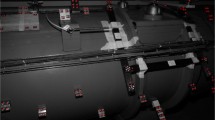Abstract
Photogrammetry-based method is gaining popularity in many fields. One of the main tasks of photogrammetry is to identify the homologous points in multiple images, which is commonly referred to as the corresponding problem. Coded targets are often placed on the surfaces of the targeted objects and have been widely used as a reliable method for solving the corresponding problem in photogrammetry for high-accuracy three-dimensional measurements. Automated recognition and identification of coded targets are of great importance in the coded target-based photogrammetry. However, false coded target identifications are inevitable due to large perspective distortion, unfavorable lighting conditions, and low-resolution, low-quality images, etc. As a result, manual corrections are often required, which are tedious, prone to error, and inefficient. In this paper, a faster R-CNN-based method has been proposed to recognize coded targets. Then, a table method has been developed to automatically identify and reject the falsely identified coded targets by taking advantages of the prior knowledge of the geometric arrangement of the coded targets. Based on that, missing coded targets can be recovered using either interpolation or extrapolation method. The effectiveness and accuracy of the proposed method are validated by implementing it into three-dimensional reconstruction of soil specimens during triaxial testing in geotechnical engineering. Experimental validation results indicate that the proposed method can achieve accurate and efficient coded target recognition and identification.







Similar content being viewed by others
References
Ahn SJ, Rauh W, Kim SI (2001) Circular coded target for automation of optical 3D-measurement and camera calibration. Int J Pattern Recognit Artif Intell 15(06):905–919
Barazzetti L, Scaioni M (2010) Development and implementation of image-based algorithms for measurement of deformations in material testing. Sensors 10(8):7469–7495
Bernat K, Tokarczyk R (2013) Automation of measurements of selected targets of photopoints in application to photogrammetric reconstruction of road accidents. Geom Environ Eng 7:15
Cha YJ, Choi W, Büyüköztürk O (2017) Deep learning-based crack damage detection using convolutional neural networks. Comput-Aided Civ Infrastruct Eng 32(5):361–378
Cheng J, Leng C, Wu J, Cui H, Lu H (2014) Fast and accurate image matching with cascade hashing for 3d reconstruction. In Proceedings of the IEEE conference on computer vision and pattern recognition, pp 1–8
Fayek S, Xia X, Li L, Zhang X (2020) Photogrammetry-based method to determine the absolute volume of soil specimen during triaxial testing. Transp Res Rec 2020:0361198120928339
Fernandez-Fernandez M, Alonso-Montes C, Bertelsen A, Mendikute A (2013) Industrial non-intrusive coded-target identification and decoding application. In: Iberian conference on pattern recognition and image analysis. Springer, Berlin, pp 790–797
Forbes K, Voigt A, Bodika N (2002) An inexpensive, automatic and accurate camera calibration method. In: Proceedings of the thirteenth annual South African workshop on pattern recognition, pp 1–6
Gao Y, Mosalam KM (2018) Deep transfer learning for image-based structural damage recognition. Comput-Aided Civ Infrastruct Eng 33(9):748–768
Hattori S, Akimoto K, Fraser C, Ono T, Imoto H (2000) Design of coded targets and automated measurement procedures in industrial vision metrology. Int Arch Photogramm Remote Sens 33(5):72–78
Van Den Heuvel FA, Kroon R, Le Poole RS (1993) Digital close-range photogrammetry using artificial targets. Int Arch Photogramm Remote Sens 29:222–222
Hung TV, Viet VQ, Van Thuat D (2019) A deep learning-based procedure for estimation of ultimate load carrying of steel trusses using advanced analysis. J Sci Technol Civ Eng 13(3):113–123
Knyaz VA, Sibiryakov AV (1998) Non-contact 3D model reconstruction using coded targets. Image 1(2). https://citeseerx.ist.psu.edu/viewdoc/download?doi=10.1.1.189.3469&rep=rep1&type=pdf
Lee S, Ha J, Zokhirova M, Moon H, Lee J (2018) Background information of deep learning for structural engineering. Arch Comput Methods Eng 25(1):121–129
Li L, Zhang X (2019) Factors influencing the accuracy of the photogrammetry-based deformation measurement method. Acta Geotech 14(2):559–574
Li L, Zhang X, Li P (2019) Evaluating a new method for simultaneous measurement of soil water retention and shrinkage curves. Acta Geotech 14(4):1021–1035
Mendikute A, Zatarain M (2012) A machine vision approach for automated raw part alignment in machine tools. Mod Mach Sci J 1:365–369
Nyarko K, Thomas C, Torres G (2016) A robust close-range photogrammetric target extraction algorithm for size and type variant targets. In: Automatic target recognition XXVI, vol 9844. International Society for Optics and Photonics, p 984403
Popescu C (2004) A contour based descriptor for object recognition. SACI Transactions, Timisoara
Salazar SE, Barnes A, Coffman RA (2015) Development of an internal camera-based volume determination system for triaxial testing. Geotech Test J 38(4):549–555
Shortis MR, Seager JW, Robson S, Harvey ES (2003) Automatic recognition of coded targets based on a Hough transform and segment matching. International Society for Optics and Photonics. In: Videometrics VII, vol 5013, pp 202–208
Soukup D, Huber-Mörk R (2014) Convolutional neural networks for steel surface defect detection from photometric stereo images. In: International symposium on visual computing. Springer, Cham, pp 668–677
Xia R, Zhao J, Liu W, Wu JH, Fu SP, Jiang J, Li J (2012) A robust recognition algorithm for encoded targets in close-range photogrammetry. J Inf Sci Eng 28:407–418
Yu Y, Hur T, Jung J, Jang IG (2019) Deep learning for determining a near-optimal topological design without any iteration. Struct Multidiscip Optim 59(3):787–799
Zhang X, Li L, Chen G, Lytton R (2015) A photogrammetry-based method to measure total and local volume changes of unsaturated soils during triaxial testing. Acta Geotech 10(1):55–82
Author information
Authors and Affiliations
Corresponding author
Additional information
Publisher's Note
Springer Nature remains neutral with regard to jurisdictional claims in published maps and institutional affiliations.
Rights and permissions
About this article
Cite this article
Xia, X., Zhang, X., Fayek, S. et al. A table method for coded target decoding with application to 3-D reconstruction of soil specimens during triaxial testing. Acta Geotech. 16, 3779–3791 (2021). https://doi.org/10.1007/s11440-021-01343-1
Received:
Accepted:
Published:
Issue Date:
DOI: https://doi.org/10.1007/s11440-021-01343-1




